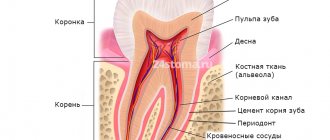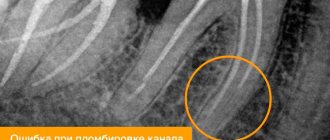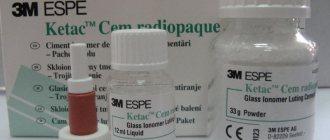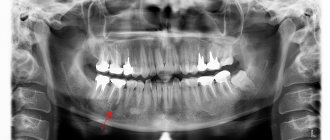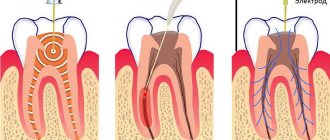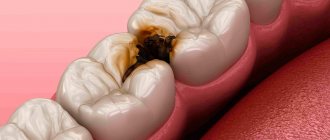31.10.2019
Many people are familiar with the procedure for removing the dental nerve (depulpation), which is used in case of inflammation in the pulp, acute pain and other indications. If you do not perform this manipulation, you can lose the entire tooth. But you need to understand that to save a tooth, removing the nerve alone is not enough. You need to carefully monitor your oral hygiene, prevent chips and cracks, and visit your dentist regularly. Read on for more details about the features of pulpless teeth. Let's consider how long a tooth lives without a nerve, and how to extend its “life” so that the tooth can last as long as possible without a removed nerve.
Indications for dental nerve removal
The pulp is a bundle of small vessels and nerve endings. Among patients, it is better known as the dental nerve. It is thanks to him that the tooth remains alive and is able to respond to external irritating factors.
When a nerve in a tooth becomes inflamed and cannot be treated, the doctor prescribes depulpation to preserve the organ. This procedure has the following indications:
- With the development of a cyst;
- Improper treatment of pulpitis, caries and other diseases;
- Mechanical damage to the tooth, which exposed the nerve;
- Increased sensitivity that occurs after dental prosthetics. Read more information about why the tooth under the crown hurts in this material;
- Dental prosthetics for the treatment of deep caries and other pathologies;
- Damage to the pulp by potent antiseptics and toxic substances.
The first symptom of inflammation of the dental nerve is its reaction to cold and hot food.
Why is a tooth without pulp considered dead?
The main thing that changes in the condition of the tooth after depulpation is that the trophism (nutrition) of the hard tissues is lost, the tooth becomes very fragile and reacts sharply to external factors.
The absence of nerve endings affects the protective function of the tooth: in the absence of a pain reaction, a person can damage the tooth by biting something hard on it and not notice it. The pulp ceases to protect the tooth from microbes, as a result of which it becomes more susceptible to caries.
As you can see, a pulpless tooth requires additional care, as it is more vulnerable than healthy ones.
Procedure technology
The depulpation procedure can be carried out in three ways:
- vital extirpation – removal of the pulp occurs completely and is carried out under local anesthesia. The procedure involves removing the nerve in just one session, but requires careful examination;
- Devital amputation is the use of a special drug to mummify part of the nerve. It involves applying a special paste that leads to pulp necrosis. This technique is used extremely rarely, since it can cause a number of complications associated with necrotic processes in the nerves. Can only be found in low-budget dental offices;
- diathermy - necrosis of the nerve occurs by applying a current discharge, after which the dead nerve is removed. An electrode is inserted into the pulp area, passing a current through itself, which not only kills the nerve, but also cauterizes the wound.
After the depulpation procedure, you may experience pain for several days that occurs when you squeeze your jaw or eat hot or cold food (drinks). This pain does not require treatment and goes away on its own.
What is depulpation
Depulpation is the removal of a nerve. More precisely, during the operation the doctor removes connective tissue formed by a large number of nerve endings and blood vessels. After the manipulation, the canals are cleaned, which eliminates acute pain and blocks the further spread of the resulting inflammatory process. A tooth without a nerve no longer receives the nutrition it needs, so it becomes fragile and serves less than its healthy counterparts. But it can fully participate in the process of chewing food and act as the basis for installing a removable or fixed prosthesis.
Possible complications
Complications can arise for several reasons: low qualifications of the dentist, his careless attitude to work, inattention, outdated equipment and much more.
Complications after depulpation occur if:
- the filling material has protruded beyond the upper part of the root;
- the filling came out;
- there was bleeding in the dental canal;
- the nerve is not completely removed;
- poor-quality filling with the formation of voids;
- a piece of instrument or other foreign object is stuck in the canal.
Some time after filling, the tooth may change color. If endomethasone was used in its treatment, the crown will begin to acquire a yellowish tint, and if resocin-formalin is used, it will turn light pink. The latter version of the filling material is used extremely rarely and the reason for this is its toxicity.
If complications still arise after removing the nerve, it is better to contact a more experienced specialist.
Change in tooth color (darkening of the tooth) - when a nerve is removed
When the nerve is removed from the tooth, after a while (from six months to several years) due to the fact that the nervous, circulatory and lymphatic supply to the tooth has ceased, the color of the tooth changes - discoloration and darkening are noted in the future. If chewing teeth have been depulped, the color change is not noticeable in most patients, unlike the front teeth. Anterior teeth after root canal treatment often require color correction to achieve smile aesthetics. This is achieved through endodontic whitening, veneers, or crowning such teeth. In most cases, when the crown of a tooth is filled or a permanent crown-shaped prosthesis is installed after root canal treatment, this discoloration is not noticeable. In cases where a tooth crown is not required, and the tooth itself is located in the frontal area of the smile, whitening or veneering helps eliminate discoloration of the teeth.
Features of a tooth without a nerve: how long will it last with strengthening from the dentist
With the removal of the nerve, the supply of blood to the tooth stops, and with it the necessary minerals. As a result, the enamel becomes thinner and further destroyed. To prevent this process after the extraction procedure, tooth restoration is required. A qualified doctor can extend his life to ten years. But even if you use the highest quality materials, the enamel will lose its strength and may eventually chip or crack.
If the chip is deep and has affected the root, the chewing element can be restored by installing a crown or modern implantation. The most widely used crown is metal-ceramic. It is tightly installed on the root of the tooth, which prevents the entry of air, food and pathogens.
Restoration using a ceramic inlay is advisable if at least 30% of the tooth is present. Its service life exceeds a standard filling, which extends the life of the chewing element.
A competent approach to treating a tooth from which the nerve has been removed allows you to preserve its integrity for a sufficiently long time, so it is better to entrust this work to an experienced dentist. If a tooth without a nerve reacts to hot food, then this is a sign of poor-quality therapy.
Tooth restoration is also possible using a reflective filling, which can extend its service life up to 10 years. This period is largely influenced by the quality of the sealed canals. Mistakes made at this stage can lead to the development of flux, cysts, fistulas and other pathologies.
If a chewing element without a nerve begins to develop complications due to improper filling of the canals, then such a tooth must be removed. That is why any dental procedures, and especially pulp removal and canal filling, must be trusted only to high-quality specialists. You may be wondering how to stop bleeding after tooth extraction.
To prevent complications and destruction of a pulpless tooth, thorough cleaning is required at least twice a day, as well as regular visits to the dental clinic.
Pulp - structure, functions, features
The pulp is also called the dental nerve. This is a soft connective tissue that contains a collection of nerve fibers, lymphatic and blood vessels. It is located in the tooth cavity (pulp chamber of the crown part of the tooth and in the root canals). Along the edge of the pulp there are cells, the processes of which are immersed in the dentin of the tooth. Thus, the pulp is closely connected with the hard tissues of the tooth. Through these connections, the trophic function is carried out; the pulp “nourishes” the walls of the tooth. Pain and mechanical sensitivity are also provided by the processes of pulp cells.
The blood supply to each tooth is provided by the common arteries and veins of the maxillofacial area. Small capillaries extend from them and enter the pulp, feeding the tooth. This structure protects the tooth from inflammation, proliferation of pathogens and other pathological processes.
The rich blood supply to the tooth also causes pain during inflammation. When the pulp becomes infected, a massive rush of blood occurs to its capillaries to provide a protective reaction, and swelling occurs inside the tooth. Enlarged vessels and soft tissues compress the nerve endings of the pulp, causing pain.
How long can a tooth with a removed nerve “last”?
The service life of a pulpless tooth is influenced by a number of factors:
- Conditions of care provided to the oral cavity and teeth;
- Quality of nutrition and degree of hardness of products;
- Efficiency of treatment and tooth restoration;
- Regular visits to the dental clinic.
- High-quality prevention of dental caries.
You can extend the service life of a chewing element without a nerve using comprehensive measures:
- minimize drinks that have a high acid content (citrus juices, carbonated drinks, etc.);
- do not eat too hard foods that can cause tooth fracture;
- include in your daily diet foods rich in iron, phosphorus, calcium and other microelements necessary for dental health;
- take vitamin-mineral complexes in autumn and spring;
- Avoid using toothpastes with a whitening effect. It is recommended to replace them with pastes for sensitive teeth.
The comprehensive application of the recommendations will extend the life of a tooth from which the nerve has been removed. Otherwise, its destruction will begin after 1-2 years and procedures for its treatment and restoration will be powerless. As a rule, such chewing elements must be removed.
What is the procedure for devital tooth depulpation?
After the dentist is sure that the anesthesia has worked, the procedure itself is carried out:
- the specialist opens access to the pulp cavity using a drill;
- a special substance is placed into the cavity, which will lead to the death of the nerve;
- the cavity with the medicine is closed with a temporary filling;
- when you return to the dentist’s office, the pulp is removed along with the neurovascular bundle, the doctor cleans the tooth cavity of dead tissue, and performs instrumental and medicinal treatment of the canals;
- after the doctor is convinced that the source of inflammation has been completely eliminated, the canals are sealed;
- The dental crown is restored using filling composite materials.
Interestingly, dentists used to often immediately close a pulpless tooth with a permanent filling, that is, they performed a vital pulpotomy. Today the practice has changed. In almost all cases, a temporary filling is first installed, allowing the specialist to assess the effectiveness of treatment and the stage of healing.
After depulpation, a tooth reaction to hot food may be observed as a result of mechanical intervention. Unpleasant sensations may persist for up to two weeks. To alleviate the patient’s condition, a specialist may prescribe special medications for this period to relieve pain.
Important: if after two weeks the painful symptoms have not disappeared, a repeat x-ray is taken, since prolonged symptoms may be an indicator of a relapse.
What is the difficulty of root canal treatment and why is it important to seal them well?
In order to carry out high-quality canal treatment and thereby ensure a long life for a “dead” tooth, it is necessary to remove all infected pulp (nerve) from the root canal, disinfect the canals and seal them hermetically.
The main difficulty in treating canals is their shape.
Below we present several videos that demonstrate a simplified version of the structure of tooth canals and options for filling them.
If all teeth had canals of such a simple shape, their treatment would not require virtuoso skills and complex equipment from dentists.
Endodontics - the treatment of canals and inflammatory processes developing around the roots of teeth, is rightfully considered the most complex branch of dentistry.
When the probability of successful treatment is high and the doctor suggests saving the tooth
An example of an “ideal” case in which it is worth fighting for a tooth:
- The crown part of the tooth is well preserved (does not have severe destruction).
- On the x-ray, the bone tissue around the tooth is almost unchanged.
- The root canals of the tooth are free of filling material, smooth and wide.
- All teeth in the oral cavity are preserved and the diseased tooth bears normal physiological load.
- The tooth had not previously bothered me.
- The patient is practically healthy.
- The patient trusts the doctor, accepts the risks of treatment and wants to try to save the tooth.
Most likely, in this case, most doctors will undertake dental treatment, because the chances of success are high.
